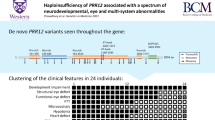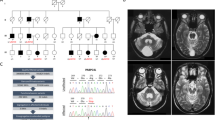Abstract
Refsum disease is an autosomal recessive disorder characterized by retinitis pigmentosa, peripheral poly neuropathy, cerebellar ataxia and increased cerebrospinal fluid protein1. Biochemically, the disorder is defined by two related properties: pronounced accumulation of phytanic acid and selective loss of the peroxisomal dioxygenase required for α-hydroxylation of phytanoyl-CoA2. Decreased phytanioacid oxidation is also observed in human cells lacking PEX7, the receptor for the type-2 peroxisomal targeting signal (PTS2; refs 3,4), suggesting that the enzyme defective in Refsum disease is targetted to peroxisomes by a PTS2. We initially identified the human PAHX and mouse Pahx genes as expressed sequence tags (ESTs) capable of encoding PTS2 proteins. Human PAHX is targetted to peroxisomes, requires the PTS2 receptor for peroxisomal localization, interacts with the PTS2 receptor in the yeast two-hybrid assay and has intrinsic phytanoyl-CoA α-hydroxylase activity that requires the dioxygenase cofactor iron and cosubstrate 2-oxoglutarate. Radiation hybrid data place PAHX on chromosome 10 between the markers D10S249 and D10S466, a region previously implicated in Refsum disease by homozygosity mapping5. We find that both Refsum disease patients examined are homozygous for inactivating mutations in PAHX, demonstrating that mutations in PAHX can cause Refsum disease.
This is a preview of subscription content, access via your institution
Access options
Subscribe to this journal
Receive 12 print issues and online access
$209.00 per year
only $17.42 per issue
Buy this article
- Purchase on Springer Link
- Instant access to full article PDF
Prices may be subject to local taxes which are calculated during checkout
Similar content being viewed by others
References
Steinberg, D. Refsum disease. in The Metabolic and Molecular Bases of Inherited Disease (eds Scriver, C. R., Beaudet, A.L., Sly, W.S. & Valle, D.) 2351–2369 (McGraw-Hill, New York, 1995).
Mihalik, S.J., Rainville, A.M. & Watkins, P.A. Phytanic acid alpha-oxidation in rat liver peroxisomes: production of alpha-hydroxyphytanoyl-CoA and formate is enhanced by dioxygenase cofactors. Eur. J. Biochem. 232, 545–551 (1995).
Lazarow, P.B. & Moser, H.W. Disorders of peroxisome biogenesis. in The Metabolic and Molecular Bases of Inherited Disease (eds Scriver, C. R., Beaudet, A.L., Sly, W.S. & Valle, D.) 2287–2324 (McGraw-Hill, New York, 1995).
Braverman, N. et al. Human PEX7 encodes the peroxisomal PTS2 receptor and is responsible for rhizomelic chondrodysplasia punctata. Nature Genet. 15, 369–376 (1997).
Nadal, N. et al. Localization of Refsum disease with increased pipecolic acidaemia to chromosome 10p by homozygosity mapping and carrier testing in a single nuclear family. Hum. Mol. Genet. 4, 1963–1966 (1995).
Subramani, S. Protein import into peroxisomes and biogenesis of the organelle. Annu. Rev. Cell Biol. 9, 445–478 (1993).
Swinkels, B.W., Gould, S.J., Bodnar, A.G., Rachubinski, R.A. & Subramani, S. A novel, cleavable peroxisomal targeting signal at the amino-terminus of the rat 3-ketoacyl-CoA thiolase. EMBO J. 10, 3255–3262 (1991).
de Vet, E.C., Zomer, A.W., Lahaut, G.J. & van den Bosch, H. Polymerase chain reaction-based cloning of alkyl-dihydroxyacetonephosphate synthase complementary DNA from guinea pig liver. J. Biol. Chem. 272, 798–803 (1997).
Hijikata, M., Ishii, N., Kagamiyama, H., Osumi, T. & Hashimoto, T. Structural analysis of cDNA for rat peroxisomal 3-ketoacyl CoA thiolase. J. Biol. Chem. 262, 8151–8158 (1987).
Jansen, G.A., Wanders, R.J.A., Watkins, P.A. & Mihalik, S.J. Phytanoyl–coenzyme A hydroxylase deficiency—the enzyme defect in Refsum's disease (letter). N. Engl. J. Med. 337, 133–134 (1997).
Wanders, R.J.A., Schumacher, H., Heikoop, J., Schutgens, R.B.H. & Tager, J.M. Human dihydroxyacetonephosphate acyltransferase deficiency: a new peroxisomal disorder. J. Inherited Metab. Dis. 15, 389–391 (1992).
Slawecki, M. et al. Identification of three distinct peroxisomal protein import defects in patients with peroxisomal biogenesis disorders. J. Cell Sci. 108, 1817–1829 (1995).
Motley, A., Hettema, E., Distel, B. & Tabak, H. Differential protein import deficiencies in human peroxisome assembly disorders. J. Cell Biol. 125, 755–767 (1994).
Gould, S.J., Krisans, S., Keller, G.A. & Subramani, S. Antibodies directed against the peroxisomal targeting signal of firefly luciferase recognize multiple mammalian peroxisomal proteins. J. Cell Biol. 110, 27–34 (1990).
Fields, S. & Song, O. A novel genetic system to detect protein–protein interactions (letter). Nature 340, 245–246 (1989).
Watkins, P.A., Howard, A.E., Gould, S.J., Avigan, J. & Mihalik, S.J. Phytanic acid activation in rat liver peroxisomes is catalyzed by long-chain acyl-CoA synthetase. J. Lipid Res. 37, 2288–2295 (1996).
Hudson, T.J. et al. An STS-based map of the human genome. Science 270, 1945–1954 (1995).
Tranchant, C. et al. A new peroxisomal disease with impaired phytanic and pipecolic acid oxidation. Neurology 43, 2044–2048 (1993).
Reuber, B.E., Karl, C., Reimann, Mihalik, S.J., & Dodt, G. Cloning and functional expression of a mammalian gene for a peroxisomal sarcosine oxidase. J. Biol. Chem. 272, 6766–6776 (1997).
Altschul, S.F., Gish, W., Miller, W., Myers, E.W. & Lipman, D.J. Basic local alignment search tool. J. Mol. Biol. 215, 403–410 (1990).
Yahraus, T. et al. The peroxisome biogenesis disorder group 4 gene, PXAAA1, encodes a cytoplasmic ATPase required for stability of the PTS1 receptor. EMBO J. 15, 2914–2923 (1996).
Chang, C.-C., Lee, W.-H., Moser, H., Valle, D. & Gould, S.J. Isolation of the human PEX12 gene, mutated in group 3 of the peroxisome biogenesis disorders. Nature Genet. 15, 385–388 (1997).
Evan, G.E., Lewis, G.K., Ramsay, G. & Bishop, J.M. Isolation of monoclonal antibodies specific for human c-myc proto-oncogene product. Mol. Cell. Biol. 5, 3610–3616 (1985).
Michaud, J. et al. Strand-separating conformational polymorphism analysis: efficacy of detection of point mutations in the human ornithine-d-aminotransferase gene. Genomics 13, 389–394 (1992).
Author information
Authors and Affiliations
Corresponding author
Rights and permissions
About this article
Cite this article
Mihalik, S., Morrell, J., Kim, D. et al. Identification of PAHX, a Refsum disease gene. Nat Genet 17, 185–189 (1997). https://doi.org/10.1038/ng1097-185
Received:
Accepted:
Issue Date:
DOI: https://doi.org/10.1038/ng1097-185
This article is cited by
-
Ichthyosis
Nature Reviews Disease Primers (2023)
-
Prognostic role of PHYH for overall survival (OS) in clear cell renal cell carcinoma (ccRCC)
European Journal of Medical Research (2021)
-
The Classification of Autosomal Recessive Cerebellar Ataxias: a Consensus Statement from the Society for Research on the Cerebellum and Ataxias Task Force
The Cerebellum (2019)
-
Chemically monoubiquitinated PEX5 binds to the components of the peroxisomal docking and export machinery
Scientific Reports (2018)
-
Systematic review of autosomal recessive ataxias and proposal for a classification
Cerebellum & Ataxias (2017)



